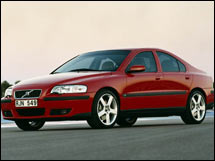Untitled Document
Environmental group contends drivers, passengers are breathing dangerous
chemicals found in car interiors; calls for new regs.
 |
|
An environmental group says Volvo is the auto manufacturer with the lowest level of toxic chemicals in car interiors.
|
A Michigan environmental group is charging that at least part of the
so-called "new car smell" is toxic, and that the interior of an automobile
has dangerous levels of various chemicals.
The report, "Toxic at any speed," comes from The Ecology Center,
an Ann Arbor, Mich.-based group. It reports that PBDEs, used as fire retardants,
and phthalates, used primarily to soften PVC plastics, are found in dangerous
amounts in dust and windshield film samples.
It called for tougher regulations to phase out the use of the chemicals as
well as voluntary moves by the auto manufacturers to stop using the products
inside of new vehicles.
It also suggested that car owners take steps to reduce the release and breakdown
of these chemicals by using solar reflectors, ventilating car interiors, and
parking outside of sunlight whenever possible.
The group says that phthalates are partly responsible for the smell associated
with new cars.
Drivers and passengers are exposed to these chemicals through inhalation and
contact with dust, according to the group's report.
"These groups of chemicals have been linked to birth defects, impaired
learning, liver toxicity, premature births and early puberty in laboratory animals,
among other serious health problems," according to the report.
"We can no longer rely just on seatbelts and airbags to keep us safe in
cars," said a statement from Jeff Gearhart, the Ecology Center's Clean
Car Campaign Director who co-authored the report. "Our research shows that
autos are chemical reactors, releasing toxins before we even turn on the ignition.
There are safer alternatives to these chemicals, and innovative companies that
develop them first will likely be rewarded by consumers."
The group found Volvo was found to have the lowest levels of phthalates and
the second-lowest levels of PBDEs, which it said made the Ford
Motor Co. (Research)-owned
unit the industry leader in terms of indoor air quality. Volvo also has the
toughest policies for phasing out these chemicals.
Other auto manufacturers had more mixed records on the two types of chemicals,
according to the group's survey. For example, Korean auto manufacturer Hyundai
had the lowest level of PBDEs, but the highest level of phthalates.
The group said it was told by Ford officials that the auto manufacturer has
eliminated PBDEs from "interior components that customers may come into
contact with." Ford had among the lowest level of PBDEs in its vehicles,
and General Motors
(Research)
and BMW vehicles also had lower-than-average levels for all chemicals tested.
But Mercedes, Chrysler, Toyota and Subaru had higher-than-average levels of
both PBDEs and phthalates.
In response to the study, one industry group defended the use of PBDEs as an
important contributor to vehicle safety.
The Bromine Science and Environmental Forum said in a statement that PBDEs
known as Deca-BDE have been extensively studied in the U.S. and Europe -- including
a 10-year-long risk assessment -- and found to be safe for continued use.
"If automobile manufacturers follow the guidance in the report, it could
result in lowering fire safety for the public, as well as promoting the use
of unidentified alternative substances about which very little may be known,"
said the group's statement. It said it is crucial that autos have the best possible
flame retardants available in case of accidents.
"In 2004 alone, there were approximately 297,000 car fires in the United
States, leading to 550 deaths. If effective flame retardants were not used,
this number would certainly be higher," the group's statement said.
Auto manufacturers have already agreed to phase out two of the three flame-retardant
chemicals cited in the report, Eron Shosteck, a spokesman for the Alliance of
Automobile Manufacturers, told the Detroit News. The remaining chemical has
been studied by the European Union for 10 years and has been proven safe, Shosteck
said.
The report was released Jan. 11 during the North American International Auto
Show in Detroit, but it received little attention outside of Michigan.

